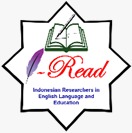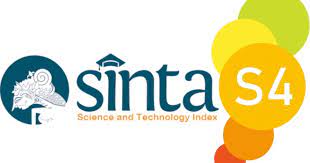Grammatical cohesion found in undergraduate student’s thesis writing: A case study at one private university in Indonesia
DOI:
https://doi.org/10.22219/englie.v5i1.31406Keywords:
Cohesive Devices, Discourse Analysis, Grammatical Cohesion, Undergraduate Student’s ThesisAbstract
Writing an excellent and comprehensive text depends on applying appropriate grammatical cohesive devices. This study aims to investigate the types and errors of the grammatical cohesive devices found in the undergraduate student's thesis. The analysis used in the present study applied the framework of Systemic Functional Linguistics (SFL) proposed by Halliday and Hasan (2014). Through the qualitative design with content analysis, this study examines two undergraduate students' theses, focusing on finding and discussing sections at one private university in Jakarta. The analysis revealed that grammatical cohesive devices in the thesis are not diverse. The data's most dominant grammatical cohesive devices are references and conjunctions—no elliptical and substitution devices are found in the data. Besides, errors in applying grammatical cohesion in the undergraduate students' writing were found, especially in using personal and demonstrative references and extension conjunctions. It indicates that the students still lack understanding in applying the knowledge of grammatical cohesion in their writing, influencing the readers' understanding in capturing information from the thesis. It implies that the knowledge of appropriate grammatical cohesion is essential for students in academic writing, predominantly undergraduate thesis, to convey the ideas and information properly and coherently.
Downloads
References
Afrianto, A. (2017). Grammatical Cohesion in Students’ Writing: A Case at Universitas Teknokrat Indonesia. LEKSEMA: Jurnal Bahasa Dan Sastra, 2, 97. https://doi.org/10.22515/ljbs.v2i2.899
Afzal, M., Mahmood, D. A., & Hayat, U. (2022). An Analysis of Grammatical Cohesion Used in the English Essays of English Grammar and Composition for Intermediate Level. International Bulletin of Linguistics and Literature (IBLL), 5(4), Article 4.
Bezanilla, M. J., Fernández-Nogueira, D., Poblete, M., & Galindo-Domínguez, H. (2019). Methodologies for teaching-learning critical thinking in higher education: The teacher’s view. Thinking Skills and Creativity, 33, 100584. https://doi.org/10.1016/j.tsc.2019.100584
Bowen, G. A. (2009). Document Analysis as a Qualitative Research Method. Qualitative Research Journal, 9(2), Article 2. https://doi.org/10.3316/QRJ0902027
Chen, Y. (2019). Developing Students’ Critical Thinking and Discourse Level Writing Skill Through Teachers’ Questions: A Sociocultural Approach. Chinese Journal of Applied Linguistics, 42(2), 141–162. https://doi.org/10.1515/CJAL-2019-0009
Creswell, J. W. (2012). Educational Research: Planning, Conducting, and Evaluating Quantitative and Qualitative Research. Pearson. https://books.google.co.id/books?id=4PywcQAACAAJ
Delfia, E., Wijana, I. D. P., & Kesuma, T. M. J. (2023). Lexical and Grammatical Cohesion in the Regional Regulation Discourse of West Sumatra Province. Journal of Language and Literature, 23(2), Article 2. https://doi.org/10.24071/joll.v23i2.6081
Eggins, S. (2004). Introduction to Systemic Functional Linguistics: 2nd Edition. A&C Black.
Episiasi, E., Syaputri, W., Suramto, S., & Kasriyati, D. (2022). Lexical and Grammatical Cohesion in the Undergraduate Students' Abstracts. Linguistic, English Education and Art (LEEA) Journal, 5(2), 143–152. https://doi.org/10.31539/leea.v5i2.3310
Graham, S. (2019). Changing How Writing Is Taught. Review of Research in Education, 43(1), 277–303. https://doi.org/10.3102/0091732X18821125
Halliday, M. A. K., & Hasan, R. (2014). Cohesion in English. Routledge.
Halliday, M. A. K., & Matthiessen, C. M. I. M. (2004). An introduction to functional grammar (3rd ed). Arnold ; Distributed in the United States of America by Oxford University Press.
Herman, H., Rafiek, M., Agustina, T., Saddhono, K., Malabar, S., Saputra, N., & Purba, R. (2023). Exploring the metafunctions to improve EFL learners’ writing ability in the perspective of systemic functional linguistics. Research Journal in Advanced Humanities, 4(2), Article 2. https://doi.org/10.58256/rjah.v4i2.1195
Hernawati, Z., & Simatupang, E. C. M. (2022). Grammatical Cohesion Found in “Venom: Let There Be Carnage” Moviescript. Budapest International Research and Critics Institute-Journal (BIRCI-Journal), 5(3), Article 3. https://doi.org/10.33258/birci.v5i3.5890
Jayanti, D., & Hidayat, D. N. (2021). Grammatical Cohesive Devices in Reading Text: A Discourse Analysis of English Test for Junior High School. JET (Journal Of English Teaching) Adi Buana, 6(01), Article 01. https://doi.org/10.36456/jet.v6.n01.2021.2963
Junina, A. K. (2022). Grammatical Cohesion in Argumentative Essays by International EAP Learners in New Zealand. International Journal of Linguistics, Literature and Translation, 5(2), 98–108. https://doi.org/10.32996/ijllt.2022.5.2.13
Khotari, C. R. (2004). Reserch methodology: Method and techniques (second revised edition). New Age International.
Kirana, R. P., Mukhrizal, M., & Jayanti, F. G. (2020). Types of Lexical Cohesion and Grammatical Cohesion in Thesis Abstracts. Jadila: Journal of Development and Innovation in Language and Literature Education, 1(1), Article 1. https://doi.org/10.52690/jadila.v1i1.14
Kusuma, L. B. D., Yunita, W., & Hardiah, M. (2022). Students’ Preferences of the Research Proposal Writing Feedback. Journal of English Education. https://www.semanticscholar.org/paper/STUDENTS%E2%80%99-PREFERENCES-OF-THE-RESEARCH-PROPOSAL-Kusuma-Yunita/06283f3e29c2ee194ba1926ac3b56875637e57d5
Leli, L. (2020). Analysis of Coherence and Cohesion on Students’ Academic Writing: A Case Study at The 3rd Year students at English Education Program. Alsuna: Journal of Arabic and English Language, 3(2), Article 2. https://doi.org/10.31538/alsuna.v3i2.980
Motallebzadeh, K., Ahmadi, F., & Hosseinnia, M. (2018). Relationship between 21st Century Skills, Speaking and Writing Skills: A Structural Equation Modelling Approach. International Journal of Instruction, 11(3), 265–276.
Muttaqin, M., Saleh, M., & Hartono, R. (2020). Using Grammatical Cohesion in the Students’ Final Project Proposal (A Case Study in UIN Walisongo Semarang in Academic Year 2019/2020). International Journal of Scientific and Research Publications (IJSRP), 11, 649–654. https://doi.org/10.29322/IJSRP.11.01.2021.p10979
Pentury, H. J., Anggraeni, A. D., & Pratama, D. (2020). Improving Students’ 21st Century Skills Through Creative Writing as A Creative Media. Deiksis, 12(02), Article 02. https://doi.org/10.30998/deiksis.v12i02.5184
Prasetyaningrum, A., Asrobi, M., Surayya, A., & Fikni, Z. (2022). Grammatical Cohesion in Students’ Undergraduate Thesis. Premise Journal of English Education, 11, 297. https://doi.org/10.24127/pj.v11i2.4744
Ratama, I. P., Padmadewi, N. N., & Artini, L. P. (2021). Teaching the 21st Century Skills (4Cs) in English Literacy Activities. Journal of Education Research and Evaluation, 5(2), Article 2. https://doi.org/10.23887/jere.v5i2.30849
Rizki, M., Hidayat, D. N., Husna, N., & Alek, A. (2022). Discourse Analysis of Grammatical Cohesion Devices in Student Explanation Texts. Eduvelop: Journal of English Education and Development, 6(1), 1–12. https://doi.org/10.31605/eduvelop.v6i1.1545
Sari, Y. I., Sumarmi, Utomo, D. H., & Astina, I. K. (2021). The Effect of Problem Based Learning on Problem Solving and Scientific Writing Skills. International Journal of Instruction, 14(2), 11–26.
Sidabutar, U. (2021). An Analysis of Lexical Cohesion on the Students’ Writing. JETAL: Journal of English Teaching & Applied Linguistic, 2(2), Article 2. https://doi.org/10.36655/jetal.v2i2.533
Syam, S. (2020). Reference: A Grammatical Cohesion In Seloka Journal Introduction Published by Semarang State University. Journal Polingua: Scientific Journal of Linguistics, Literature and Language Education, 9(1), Article 1. https://doi.org/10.30630/polingua.v9i1.132
Toba, R., Noor, W. N., & Sanu, L. O. (2019). The Current Issues of Indonesian EFL Students’ Writing Skills: Ability, Problem, and Reason in Writing Comparison and Contrast Essay. Dinamika Ilmu, 19(1), Article 1. https://doi.org/10.21093/di.v19i1.1506
Wrahatnolo, T. & Munoto. (2018). 21st centuries skill implication on educational system. IOP Conference Series: Materials Science and Engineering, 296(1), 012036. https://doi.org/10.1088/1757-899X/296/1/012036
Zaimar, O. K. S. (2009). Telaah wacana. The Intercultural Institute.
Downloads
Published
How to Cite
Issue
Section
License
Copyright (c) 2024 Ulfa et al.

This work is licensed under a Creative Commons Attribution-ShareAlike 4.0 International License.
Authors who publish with English Learning Innovation (englie) agree to the following terms:
- For all articles published in English Learning Innovation (englie), copyright is retained by the authors. Authors give permission to the publisher to announce the work with conditions. When the manuscript is accepted for publication, the authors agree to automatic transfer of the publishing right to the publisher.
- Authors retain copyright and grant the journal right of first publication with the work simultaneously licensed under a Creative Commons Attribution-ShareAlike 4.0 International License that allows others to share the work with an acknowledgement of the work's authorship and initial publication in this journal.
- Authors are able to enter into separate, additional contractual arrangements for the non-exclusive distribution of the journal's published version of the work (e.g., post it to an institutional repository or publish it in a book), with an acknowledgment of its initial publication in this journal.
- Authors are permitted and encouraged to post their work online (e.g., in institutional repositories or on their website) prior to and during the submission process, as it can lead to productive exchanges, as well as earlier and greater citation of published work (See The Effect of Open Access).
This work is licensed under a Creative Commons Attribution-ShareAlike 4.0 International License.
















1.png)












